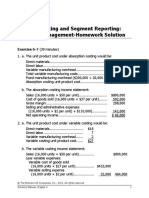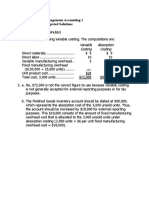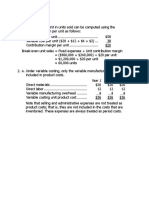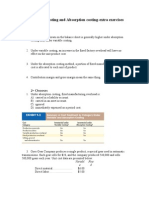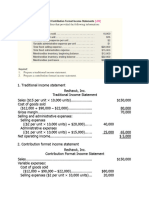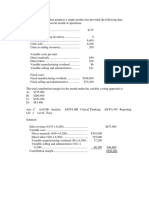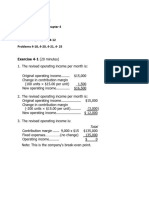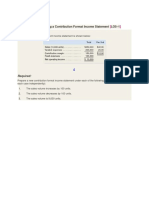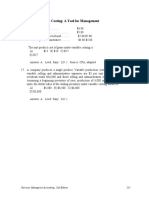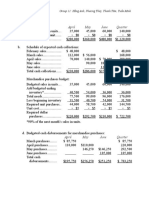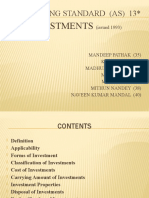Exercise MA
Exercise MA
Uploaded by
thanhntt21Copyright:
Available Formats
Exercise MA
Exercise MA
Uploaded by
thanhntt21Original Description:
Copyright
Available Formats
Share this document
Did you find this document useful?
Is this content inappropriate?
Copyright:
Available Formats
Exercise MA
Exercise MA
Uploaded by
thanhntt21Copyright:
Available Formats
Exercise 1-6
1. Traditional income statement
Cherokee Inc.
Traditional Income Statement
Sales ($30 per unit × 20,000 units)................... $600,000
Cost of goods sold
($24,000 + $180,000 – $44,000).................... 160,000
Gross margin .................................................. 440,000
Selling and administrative expenses:
Selling expenses
(($4 per unit × 20,000 units) + $40,000)...... $120,000
Administrative expenses
(($2 per unit × 20,000 units) + $30,000)...... 70,000 190,000
Net operating income....................................... $250,000
2. Contribution format income statement
Cherokee Inc.
Contribution Format Income Statement
Sales ($30 per unit × 20,000 units)................... $600,000
Variable expenses:
Cost of goods sold
($24,000 + $180,000 – $44,000) ................. $160,000
Selling expenses ($4 per unit × 20,000 units).. 80,000
Administrative expenses
($2 per unit × 20,000 units) ........................ 40,000 280,000
Contribution margin ......................................... 320,000
Fixed expenses:
Selling expenses ........................................... 40,000
Administrative expenses ................................ 30,000 70,000
Net operating income....................................... $250,000
Exercise 1-7
1a. The total direct manufacturing cost incurred is computed as follows:
Direct materials per unit............................ $7.00
Direct labor per unit.................................. 4.00
Direct manufacturing cost per unit (a) ........ $11.00
Number of units sold (b) ........................... 20,000
Total direct manufacturing cost (a) × (b) .... $220,000
1b. The total indirect manufacturing cost incurred is computed as follows:
Variable manufacturing overhead per unit ... $1.50
Fixed manufacturing overhead per unit....... 5.00
Indirect manufacturing cost per unit (a)...... $6.50
Number of units sold (b) ........................... 20,000
Total indirect manufacturing cost (a) × (b).. $130,000
Note: The average fixed manufacturing overhead cost per unit of $5.00
is valid for only one level of activity—20,000 units produced.
2a. The total manufacturing cost that is directly traceable to the
Manufacturing Department is computed as follows:
Direct materials per unit............................ $7.00
Direct labor per unit.................................. 4.00
Variable manufacturing overhead per unit ... 1.50
Fixed manufacturing overhead per unit....... 5.00
Total manufacturing cost per unit (a).......... $17.50
Number of units sold (b) ........................... 20,000
Total direct costs (a) × (b) ........................ $350,000
2b. None of the manufacturing costs should be treated as indirect costs
when the cost object is the Manufacturing Department.
3a. The first step in calculating the total direct selling expense is to
determine the fixed portion of the sales representatives’ compensation
as follows:
Fixed selling expense per unit (a)............... $3.50
Number of units sold (b) ........................... 20,000
Total fixed selling expense (a) × (b)........... $70,000
Total fixed selling expense (a).................... $70,000
Advertising expenditures (b)...................... $50,000
Total fixed portion of the sales
representatives’ compensation (a) ‒ (b) ... $20,000
The second step is to calculate the total direct selling expense that is
traceable to individual sales representatives as follows:
Sales commissions per unit (a) .................. $1.00
Number of units sold (b) ........................... 20,000
Total sales commission (a) × (b)................ $20,000
Fixed portion of sales representatives’
compensation ........................................ 20,000
Total direct selling expense........................ $40,000
3b. The total indirect selling expense that cannot be traced to individual
sales representatives is $50,000. The advertising expenditures cannot
be traced to specific sales representatives.
4. No. Kubin’s administrative expenses could be direct or indirect
depending on the cost object. For example, the chief financial officer’s
salary would be an indirect cost if the cost object is units of production;
however, his salary would be a direct cost if the cost object is the
Finance Department that he oversees.
Exercise 1-8
1. Direct materials ......................................... $ 7.00
Direct labor............................................... 4.00
Variable manufacturing overhead ................ 1.50
Variable manufacturing cost per unit ........... $12.50
Variable manufacturing cost per unit (a) ...... $12.50
Number of units produced (b)..................... 20,000
Total variable manufacturing cost (a) × (b).. $250,000
Average fixed manufacturing overhead per
unit (c) .................................................. $5.00
Number of units produced (d)..................... 20,000
Total fixed manufacturing cost (c) × (d) ...... 100,000
Total product cost...................................... $350,000
Note: The average fixed manufacturing overhead cost per unit of $5.00
is valid for only one level of activity—20,000 units produced.
2. Sales commissions..................................... $1.00
Variable administrative expense .................. 0.50
Variable selling and administrative per unit... $1.50
Variable selling and admin. per unit (a)........ $1.50
Number of units sold (b) ............................ 20,000
Total variable selling and admin. expense
(a) × (b) ............................................. $30,000
Average fixed selling and administrative
expense per unit ($3.50 fixed selling +
$2.50 fixed administrative) (c).................. $6.00
Number of units sold (d) ............................ 20,000
Total fixed selling and administrative
expense (c) × (d) ................................... 120,000
Total period cost........................................ $150,000
Note: The average fixed selling and administrative expense per unit of
$6.00 is valid for only one level of activity—20,000 units sold.
3. Direct materials ......................................... $ 7.00
Direct labor............................................... 4.00
Variable manufacturing overhead ................ 1.50
Variable manufacturing cost per unit ........... $12.50
Variable manufacturing cost per unit (a) ...... $12.50
Number of units produced (b)..................... 22,000
Total variable manufacturing cost (a) × (b).. $275,000
Total fixed manufacturing cost (see
requirement 1) ....................................... 100,000
Total product cost...................................... $375,000
4. Sales commissions..................................... $1.00
Variable administrative expense .................. 0.50
Variable selling and administrative per unit... $1.50
Variable selling and admin. per unit (a)........ $1.50
Number of units sold (b) ............................ 18,000
Total variable selling and admin. expense
(a) × (b) ............................................. $27,000
Total fixed selling and administrative
expense (see requirement 2) ................... 120,000
Total period cost........................................ $147,000
Exercise 1-12
1. The computations for parts 1a through 1e are as follows:
a. The cost of batteries in Raw Materials:
Beginning raw materials inventory............. 0
Plus: Battery purchases............................ 8,000
Batteries available ................................... 8,000
Minus: Batteries withdrawn ...................... 7,600
Ending raw materials inventory (a)............ 400
Cost per battery (b)................................. $80
Raw materials on April 30th (a) × (b)......... $32,000
b. The cost of batteries in Work in Process:
Beginning work in process inventory ......... 0
Plus: Batteries withdrawn for production.... 7,500
Batteries available ................................... 7,500
Minus: Batteries transferred to finished
goods (7,500 × 90%)............................ 6,750
Ending work in process inventory (a)......... 750
Cost per battery (b)................................. $80
Work in process on April 30th (a) × (b) ...... $60,000
c. The cost of batteries in Finished Goods:
Beginning finished goods inventory ........... 0
Plus: Batteries transferred in from work in
process (see requirement b) .................. 6,750
Batteries available ................................... 6,750
Minus: Batteries transferred out to cost of
goods sold (6,750 × (100% ‒ 30%)) ...... 4,725
Ending finished goods inventory (a) .......... 2,025
Cost per battery (b)................................. $80
Finished goods on April 30th (a) × (b)........ $162,000
d. The cost of batteries in Cost of Goods Sold:
Number of batteries (see requirement c)
(a)....................................................... 4,725
Cost per battery (b)................................. $80
Cost of goods sold for April (a) × (b)......... $378,000
e. The cost of batteries included in selling expense:
Number of batteries (a) ........................... 100
Cost per battery (b)................................. $80
Selling expense for April (a) × (b)............. $8,000
2. Raw Materials, Work in Process, and Finished Goods would appear on
the balance sheet. Cost of Goods Sold and Selling Expense would
appear on the income statement.
You might also like
- Piedmont Trailer Manufacturing Comany SolutionsDocument26 pagesPiedmont Trailer Manufacturing Comany SolutionsEve Diekemper100% (1)
- Ab Costing - ProblemsDocument8 pagesAb Costing - ProblemsMarcial VillegasNo ratings yet
- Chapter 6 HomeworkDocument10 pagesChapter 6 HomeworkAshy Lee0% (1)
- 20210213174013D3066 - Soal Cost System and Cost AccumulationDocument6 pages20210213174013D3066 - Soal Cost System and Cost AccumulationLydia limNo ratings yet
- AF2110 Management Accounting 1 Assignment 05 Suggested Solutions Exercise 6-13 (20 Minutes)Document12 pagesAF2110 Management Accounting 1 Assignment 05 Suggested Solutions Exercise 6-13 (20 Minutes)Shadow IpNo ratings yet
- ANSWERS TO PRACTICE MIDTERM (Multiple Choice) : RequiredDocument5 pagesANSWERS TO PRACTICE MIDTERM (Multiple Choice) : RequiredGwendolyn Chloe PurnamaNo ratings yet
- Answer To Assignment #2 - Variable Costing PDFDocument14 pagesAnswer To Assignment #2 - Variable Costing PDFVivienne Rozenn LaytoNo ratings yet
- Problem 7-8 (30 Minutes) : Year 1 Year 2Document4 pagesProblem 7-8 (30 Minutes) : Year 1 Year 2Nor Hanna DanielNo ratings yet
- Ch7 Variable Absoorption Extra ExcersisesDocument7 pagesCh7 Variable Absoorption Extra ExcersisesSarah Al MuallaNo ratings yet
- Traditional and Contribution Inc. Stat (TA)Document4 pagesTraditional and Contribution Inc. Stat (TA)Fatma AbdelnaemNo ratings yet
- CB2101_Exercise & HW Solutions_Ch2 and Ch3Document19 pagesCB2101_Exercise & HW Solutions_Ch2 and Ch3lokyanleelouis1214No ratings yet
- ExercisesDocument4 pagesExercisesvanessaNo ratings yet
- StudentsCH01 SM FinalDocument71 pagesStudentsCH01 SM Finalhayaayoubb55No ratings yet
- 21312Document3 pages21312Alexis AlipudoNo ratings yet
- Review Problem: Differential Analysis: RequiredDocument17 pagesReview Problem: Differential Analysis: RequiredBảo Anh Phạm100% (1)
- 2652Document3 pages2652Alexis AlipudoNo ratings yet
- A Chp6 TUTDocument11 pagesA Chp6 TUTYong Jing YinNo ratings yet
- Practice Question - Absorption & Variable Costing - May 2015Document8 pagesPractice Question - Absorption & Variable Costing - May 2015Muhammad Ali MeerNo ratings yet
- Acc 325 Ch. 8 AnswersDocument10 pagesAcc 325 Ch. 8 AnswersMohammad WaleedNo ratings yet
- Chapter 3 Homework SolutionsDocument10 pagesChapter 3 Homework SolutionsshamailNo ratings yet
- CH 8Document20 pagesCH 8Firas HamadNo ratings yet
- Garrison 13th Edition Chapter 9Document18 pagesGarrison 13th Edition Chapter 9Ali HaiderNo ratings yet
- Answers Chapter 4 - ACCT5204Document16 pagesAnswers Chapter 4 - ACCT5204abdulraheem.eesNo ratings yet
- Problem 2Document18 pagesProblem 2HaideBrocalesNo ratings yet
- Chapter 19 HomeworkDocument2 pagesChapter 19 Homeworkwilliamarnold16No ratings yet
- Solutions To Self-Study QuestionsDocument47 pagesSolutions To Self-Study QuestionsChristina ZhangNo ratings yet
- Chapter 8-SolutiondocxDocument17 pagesChapter 8-Solutiondocxevani1998No ratings yet
- 2010-07-28 202232 ShansismanDocument19 pages2010-07-28 202232 ShansismanHassan Ansari100% (1)
- Exercise CH 2Document17 pagesExercise CH 2UserNo ratings yet
- Solutions 1Document4 pagesSolutions 1Markus H.No ratings yet
- Solution To Exercise 5-1 and 5-4Document2 pagesSolution To Exercise 5-1 and 5-4Hassan ArafatNo ratings yet
- Problem 2-24: © The Mcgraw-Hill Companies, Inc., 2010. All Rights Reserved. Solutions Manual, Chapter 2 51Document2 pagesProblem 2-24: © The Mcgraw-Hill Companies, Inc., 2010. All Rights Reserved. Solutions Manual, Chapter 2 51Rizky Wahyu FebriyantoNo ratings yet
- Chapter 7 Solutions-2Document9 pagesChapter 7 Solutions-2mackkshellNo ratings yet
- AF2110 Management Accounting 1 Assignment 08 Suggested Solutions Exercise 8-10 (45 Minutes)Document14 pagesAF2110 Management Accounting 1 Assignment 08 Suggested Solutions Exercise 8-10 (45 Minutes)Shadow IpNo ratings yet
- 201B Exam 3 PracticeDocument16 pages201B Exam 3 PracticeChanel NguyenNo ratings yet
- Problem 9-15 (60 Minutes) : © The Mcgraw-Hill Companies, Inc., 2008. All Rights Reserved. Solutions Manual, Chapter 9 1Document14 pagesProblem 9-15 (60 Minutes) : © The Mcgraw-Hill Companies, Inc., 2008. All Rights Reserved. Solutions Manual, Chapter 9 1Tanvir AhmedNo ratings yet
- 5204 Solutions For Problems 2-17, 2-22, 2-26 (12th Ed)Document7 pages5204 Solutions For Problems 2-17, 2-22, 2-26 (12th Ed)assignmentsbysinghNo ratings yet
- 1 DoneDocument9 pages1 DoneНикита ШтефанюкNo ratings yet
- Accntng HomeowrkDocument2 pagesAccntng HomeowrkAntonNo ratings yet
- Solution CH.8Document10 pagesSolution CH.8Thanawat PHURISIRUNGROJNo ratings yet
- Variable Costing and Absorption CostingDocument6 pagesVariable Costing and Absorption CostingSid Chaudhary100% (1)
- Selected Tutorial Solutions CHPT 1-5Document22 pagesSelected Tutorial Solutions CHPT 1-5Silo KetenilagiNo ratings yet
- حل اسئلة الكتابDocument13 pagesحل اسئلة الكتابAzDream ACC21No ratings yet
- Cornerstone Exercises Cornerstone Exercise 17.1Document30 pagesCornerstone Exercises Cornerstone Exercise 17.1Nirwana PuriNo ratings yet
- Solutions Ch. 7 ABCDocument11 pagesSolutions Ch. 7 ABCThanawat PHURISIRUNGROJNo ratings yet
- Lecture 6.1-General Cost Classifications (Problem 1)Document3 pagesLecture 6.1-General Cost Classifications (Problem 1)Nazmul-Hassan Sumon100% (4)
- Soal Cost System and Cost AccumulationDocument5 pagesSoal Cost System and Cost AccumulationSugata S100% (1)
- Chapter 2 HandoutDocument7 pagesChapter 2 HandoutAnonymous jm4quoNo ratings yet
- Solutions of Exercises - Management Accounting - Chapter 2 - 3 - 4Document9 pagesSolutions of Exercises - Management Accounting - Chapter 2 - 3 - 4ngochoangbich2004No ratings yet
- Tutorial Solutions Chap 2 3Document16 pagesTutorial Solutions Chap 2 3Fitzmore PetersNo ratings yet
- Solution To Chapter 2 E2 24,2 30, P2 40, 2 37 E2 32,28 (1 3 Parts) P2 43,2 54Document7 pagesSolution To Chapter 2 E2 24,2 30, P2 40, 2 37 E2 32,28 (1 3 Parts) P2 43,2 54ReilpeterNo ratings yet
- Budgets – Assignment – Model AnswerDocument7 pagesBudgets – Assignment – Model AnswerAhmed MokhtarNo ratings yet
- The Foundational 15 Oslo CompanyDocument5 pagesThe Foundational 15 Oslo CompanyCorissa Gilley0% (1)
- Chapter 7 Variable Costing: A Tool For Management: Garrison, Managerial Accounting, 12th Edition 313Document2 pagesChapter 7 Variable Costing: A Tool For Management: Garrison, Managerial Accounting, 12th Edition 313yes yesnoNo ratings yet
- Practice Test E 1: Xercise (Ron Chemicals) 1. Physical Units Method Product: A-1 B-3 C-2 Q-9 TotalDocument2 pagesPractice Test E 1: Xercise (Ron Chemicals) 1. Physical Units Method Product: A-1 B-3 C-2 Q-9 TotalKaren Joyce SinsayNo ratings yet
- Case 8 23Document5 pagesCase 8 23Thinh VuNo ratings yet
- CASE Limiting FactorsDocument2 pagesCASE Limiting FactorsEhrom SaidovNo ratings yet
- Solutions Chapter 8 Exercises 1-8Document8 pagesSolutions Chapter 8 Exercises 1-8Laira TupasNo ratings yet
- Problem 2Document3 pagesProblem 2Mohammed Al ArmaliNo ratings yet
- Visual Financial Accounting for You: Greatly Modified Chess Positions as Financial and Accounting ConceptsFrom EverandVisual Financial Accounting for You: Greatly Modified Chess Positions as Financial and Accounting ConceptsNo ratings yet
- Some Small Countries Do It Better: Rapid Growth and Its Causes in Singapore, Finland, and IrelandFrom EverandSome Small Countries Do It Better: Rapid Growth and Its Causes in Singapore, Finland, and IrelandNo ratings yet
- Capital Gains - Chapter Notes - Nikunj Goenka SirDocument67 pagesCapital Gains - Chapter Notes - Nikunj Goenka SirAnkur PattaniNo ratings yet
- FAC1601 E-Tutor Class Presentation - 15 April 2024-CombinedDocument44 pagesFAC1601 E-Tutor Class Presentation - 15 April 2024-CombinedTHABANGNo ratings yet
- Index Table: Part - IDocument91 pagesIndex Table: Part - ISayedMohammadAkhtarNo ratings yet
- Screen Based TradingDocument3 pagesScreen Based TradingexamonclickNo ratings yet
- Workshop 2 Financial EducationDocument10 pagesWorkshop 2 Financial EducationAnny GarciaNo ratings yet
- Lecture # 26Document20 pagesLecture # 26bwcs1122No ratings yet
- Materi 210312Document71 pagesMateri 210312Novita HalimNo ratings yet
- II If en April2015 EquitycompoundersDocument8 pagesII If en April2015 EquitycompoundersbgyggghjkkNo ratings yet
- IC Restaurant Balance Sheet 2024Document2 pagesIC Restaurant Balance Sheet 2024Siyabonga MncubeNo ratings yet
- Dividends Exercises Chapter 9 For Assignment PDFDocument2 pagesDividends Exercises Chapter 9 For Assignment PDFCharlon OdivelasNo ratings yet
- Chapter 3 Quick StudyDocument10 pagesChapter 3 Quick StudyPhạm Hồng Trang Alice -No ratings yet
- ITA Cashflow Financial Statment AnalysisDocument59 pagesITA Cashflow Financial Statment AnalysisRatish Kumar mishra100% (1)
- Sybcom Sem Iv - Audit Chapter 1 & 2Document24 pagesSybcom Sem Iv - Audit Chapter 1 & 2Pravin KharateNo ratings yet
- Corporatre ValuationDocument46 pagesCorporatre ValuationVipin MehtaNo ratings yet
- PhonePe Statement Mar2023 Mar2024Document452 pagesPhonePe Statement Mar2023 Mar2024abhijit patilNo ratings yet
- Acc Business Combination NotesDocument118 pagesAcc Business Combination NotesTheresaNo ratings yet
- IND AS 28 - Loss Making AssociateDocument2 pagesIND AS 28 - Loss Making Associatehsay.hsay.hsay.hsayNo ratings yet
- PDF Business Laws and RegulationsDocument59 pagesPDF Business Laws and Regulationseldridge floresNo ratings yet
- Investments: Accounting Standard (As) 13Document13 pagesInvestments: Accounting Standard (As) 13ankitmogheNo ratings yet
- Ia1 NotesDocument23 pagesIa1 NotesAssej C AustriaNo ratings yet
- Cost Accounting and Control - SyllabusDocument3 pagesCost Accounting and Control - SyllabusVincent AbellaNo ratings yet
- Chapter 15 - Consolidation: Controlled Entities: Review QuestionsDocument13 pagesChapter 15 - Consolidation: Controlled Entities: Review QuestionsShek Kwun Hei100% (1)
- SFA Guidelines On Licensing Registration and Conduct of Business For FMCs Nov22Document27 pagesSFA Guidelines On Licensing Registration and Conduct of Business For FMCs Nov22simsiyangNo ratings yet
- Massif Capital Pitch DeckDocument18 pagesMassif Capital Pitch DecksidjhaNo ratings yet
- Chapter 10 - Financial PlanningDocument69 pagesChapter 10 - Financial PlanningNgọc Trân Trần NguyễnNo ratings yet
- Financial Statements As at 31st Dec, 2019 - 0 PDFDocument1 pageFinancial Statements As at 31st Dec, 2019 - 0 PDFMsuyaNo ratings yet
- Rasoya OrderDocument139 pagesRasoya OrdersiddhantNo ratings yet
- M2U SA 243131 Apr 2024Document19 pagesM2U SA 243131 Apr 2024barumble247No ratings yet
- Fin315 - Business Finance Chapter 10 and 11 NAME (PLEASE PRINT)Document8 pagesFin315 - Business Finance Chapter 10 and 11 NAME (PLEASE PRINT)Ryan Xuan0% (1)


